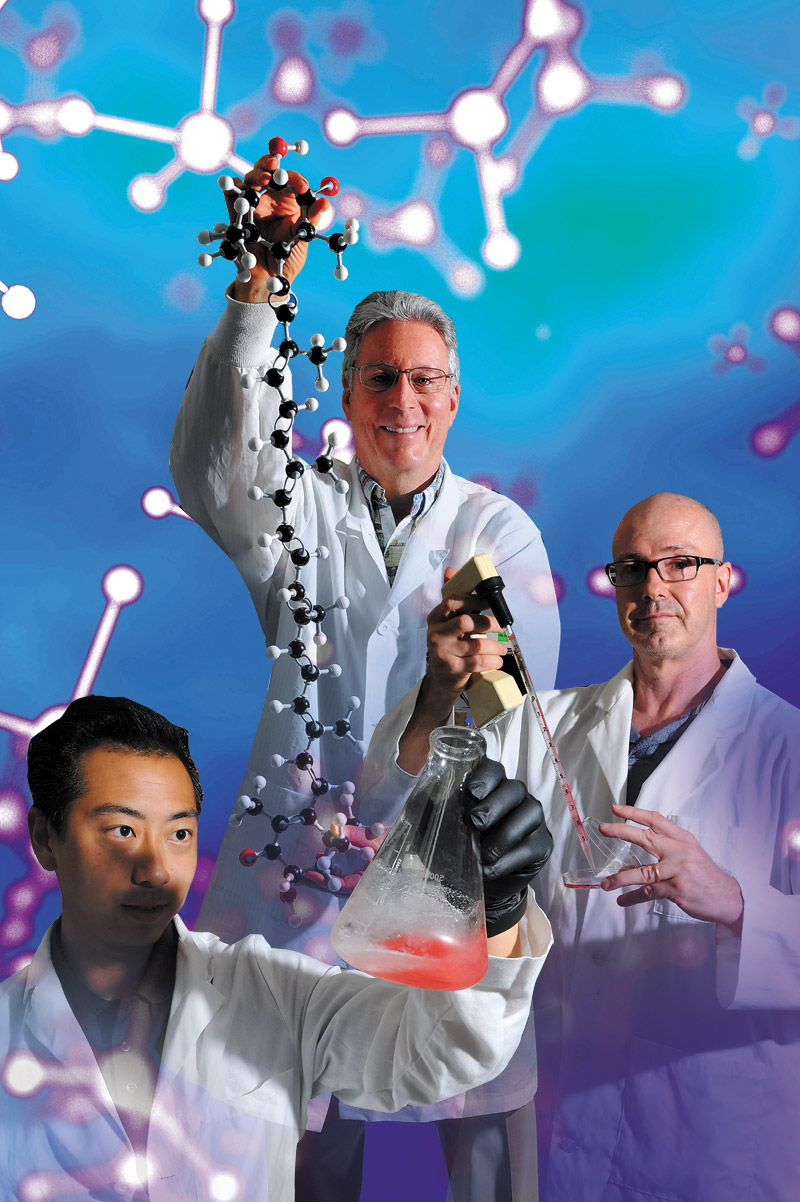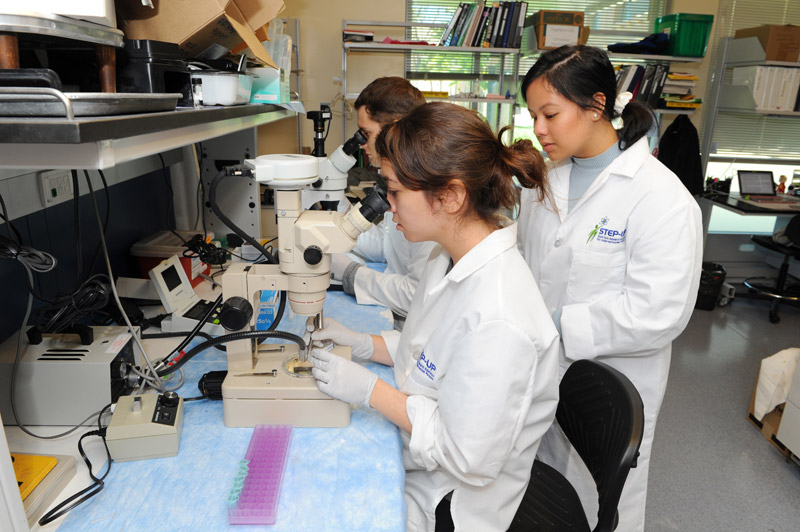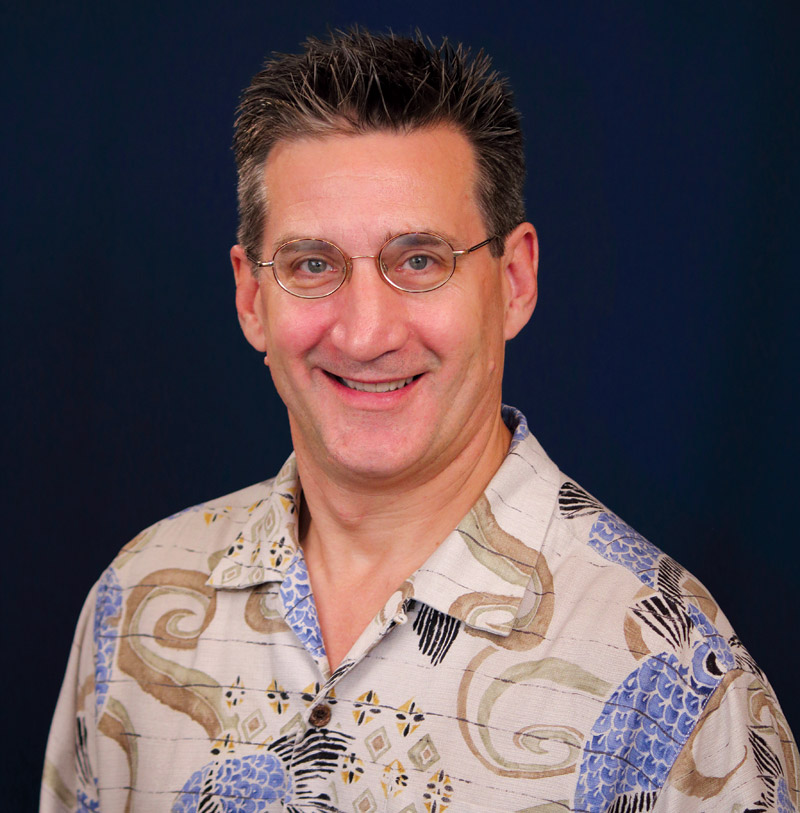THe Secret To A Longer Life

(From left) Trevor Torigoe, University of Hawai‘i John A. Burns School of Medicine Ph.D. student; David Watumull, Cardax, Inc. president and CEO; and Richard Allsopp, Ph.D., JABSOM Institute for Biogenesis Research associate professor and researcher
Humans have long sought to extend their lifespans by staving off physical decline. Gilgamesh went on a quest to find immortality, as did Juan Ponce de Leon, whose search for the fountain of youth ended with his discovery of Florida. Others, like Cleopatra, known for her milk-and-honey baths, were said to have tried reversing the effects of aging (or at least prevent them for as long as possible).
But what has been a futile search for the “holy grail” of medicine might actually not be so far-fetched any longer.
In fact, the work being done right here at home might very well turn science fiction into reality one day soon.
University of Hawai‘i John A. Burns School of Medicine (JABSOM) formed a partnership with Hawai‘i-based life sciences company Cardax Inc. and brought to light a remarkable discovery in terms of how people age.

University of Hawai‘i at Manoa John A. Burns School of Medicine students Madison Williams (front), Pomaikai Canaday (right) and Ross Villiger (back) dissect ureters from mouse embryos.
The March announcement of their findings — all accumulated, analyzed and tested in Hawai‘i — has shaken the medical field.
What the news confirmed was the ability of Cardax’s astaxanthin compound CDX-085 to significantly stimulate FOXO3, a gene all humans have and one that has a proven role in longevity.
“It’s one thing to know that a gene does something,” says David Watumull, president and CEO of Cardax. “But it’s another to be able to do something about it. In the scientific world, that’s very unusual.”
Researchers have long understood FOXO3 and its involvement with aging, and Cardax’s work with CDX-085 has been known for more than a decade to be important in reducing inflammation — but it’s the relationship between the two that is the innovative breakthrough.
Inflammation, adds Watumull, is the underlying driver for most chronic illnesses related to aging, such as cardiovascular disease, gastrointestinal disease, liver disease and kidney disease. Even those with dementia, depression, Alzheimer’s, PTSD and bipolar disorder are impacted by inflammation.

This kind of commitment, I mean, this is an amazing service they’ve done. Not just for Hawai‘i and for this country, but for the world.
— DR. BRADLEY WILLCOX JABSOM Department of Geriatric Medicine professor and director of research
“These are all really important tissues with regard to aging,” says Dr. Bradley Willcox, JABSOM Department of Geriatric Medicine professor and director of research. “If your liver doesn’t work, you’re done. If your muscles don’t work, you’re crippled. If your brain doesn’t work, you might as well be done. If your heart doesn’t work, you’re certainly done.”
It is such a vital aspect of overall health that many have started using the term “inflamm-aging.”
Studies that test aging utilize life forms such as yeast, flies, worms and mice — model organisms made up of genes that are conserved across evolution.
And the JABSOM-Cardax study moved science up the phylogenetic ladder. What once was only studied in worms has now been proven in mammals, specifically mice, which are an important physiological model, as they share a big chunk of their genome with humans.
The preliminary research conducted by JABSOM-Cardax — the first of its kind to test astaxanthin’s ability to activate FOXO3 in mammals — fed mice normal fare and others food containing a low or high dose of CDX-085.
The study found that CDX-085 stimulates FOXO3 to express properties that positively affect aging.
“We found a nearly 90-percent increase in the activation of the FOXO3 ‘longevity gene’ in the mice fed the higher dose of the astaxanthin compound CDX-085,” stated Richard Allsopp, Ph.D., JABSOM Institute for Biogenesis Research associate professor, in a release.
FOXO3 comes in two basic forms, with a single DNA letter distinction — those with TT (most of the population) and those that have a G somewhere in the mix (GT or GG).
About one-third of the population has GT, which doubles the odds of living to 100, says Willcox. Those lucky enough to have GG? They have triple the odds of living to be 100. For those fortunate few, they have won the genetic lottery, so to speak.
“You really just need to be a carrier to have just one of those G letters to have the longevity effect,” Willcox explains.
But, adds Watumull, a person doesn’t need to have a “good” FOXO3 version for Cardax’s CDX-085 compound to work. It simply turns FOXO3 on, making it as if a TT person has the GT or GG version.
“You’re not at a loss,” Willcox continues. “Because now we have a way to activate it.”
Cardax and JABSOM announced the results of their study earlier this year, but representatives are quick to note that nothing would have come to fruition if it weren’t for the Kuakini Honolulu Heart Program, which is one of the largest ongoing studies in the world on aging men.
JABSOM researchers chose 30 genes that had been shown in model organisms to be important for longevity and were able to compare them to genetic data from
Kuakini Honolulu Heart Program. The gene that stood out? FOXO3.
“This data set doesn’t exist anywhere else in the world,” says Watumull of Kuakini Honolulu Heart Program. “And that’s what has resulted from that is this breakthrough.”
Initial study volunteers — about 120 currently still living — have continued to give blood samples and medical information for more than 50 years (the program started in 1965), making the data pool even richer, and their children also have volunteered for the offspring study.
“This kind of commitment, I mean, this is an amazing service they’ve done,” says Willcox. “Not just for Hawai‘i and for this country, but for the world.”
“And to actually take work that’s being done in Hawai‘i, following from the 1960s with Japanese-American men, coming up with a gene that affects longevity, defining it, knowing what it is, and then having another Hawai‘i company actually be able to do something — all in the state — that’s really unusual,” Watumull adds. “That’s really unusual to be able to do any of that, any one of those steps, but to put them all together and all in Hawai‘i, that’s a breakthrough.”
Others already are seeing the benefits of the JABSOM-Cardax findings.
Just last month, CDX-085 was chosen for the National Institutes on Aging’s prestigious Interventions Testing Program, which, says Willcox is a game changer. He, along with Allsopp, submitted a proposal in the hopes that the compound would be one of the very few to be chosen.
And its selection, adds Watumull, is totally validating.
“We’re the ones that discovered this, we put together this concept, we can export it, bring people here to experience the benefits,” he muses.
Linking CDX-085 and FOXO3 has provided, in a way, the catalyst for numerous medical possibilities. According to JABSOM, scientists also are planning human clinical trials to see, for example, if CDX-085 could “improve cognitive function in people with early dementia.”
It is their hope that one day Hawai‘i can be the foremost expert on aging — joining the ranks of medically renowned, field-specific institutions such as MD Anderson Cancer Center, Cleveland Clinic and Mayo Clinic. And, says Watumull, it’s not improbable in the slightest. At least, not anymore anyway.
“We have the tools today to offer something meaningful, real and unparalleled at this point in time,” he says. “Hawai‘i can serve as the kind of anti-aging center of excellence for the world.”
For more information, visit cardaxpharma.com or jabsom.hawaii.edu.






